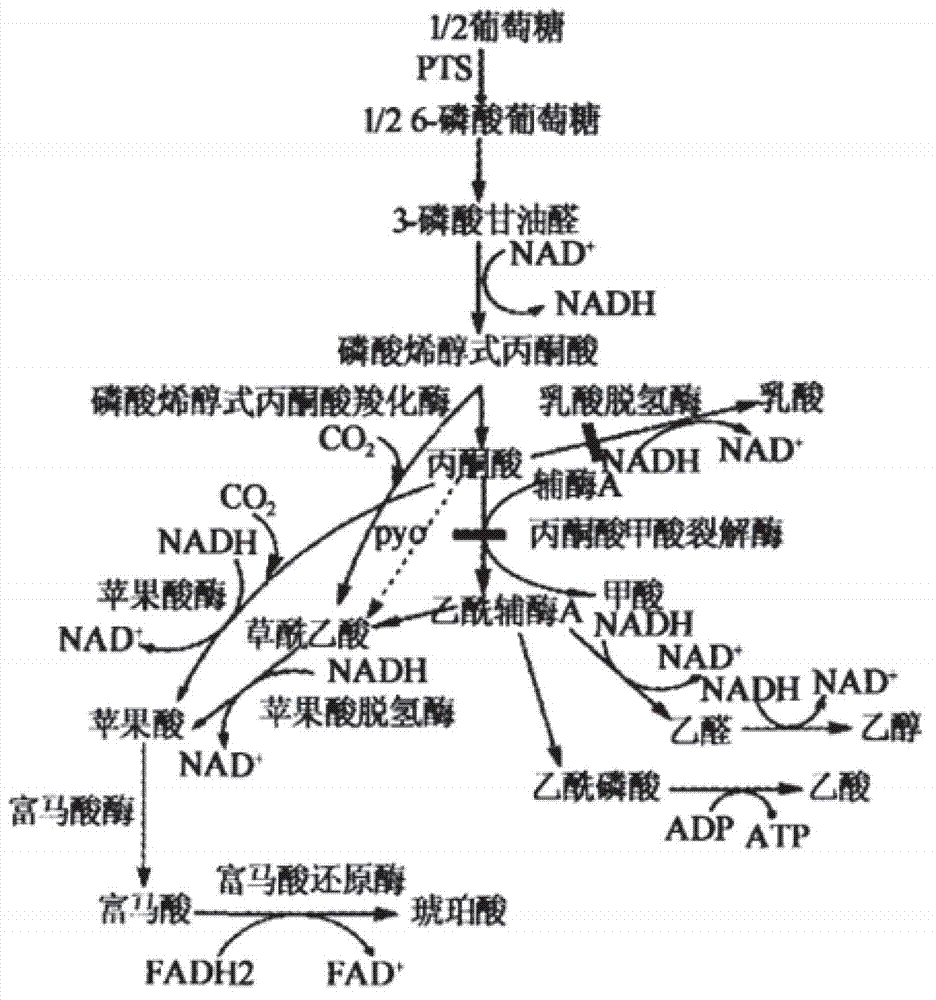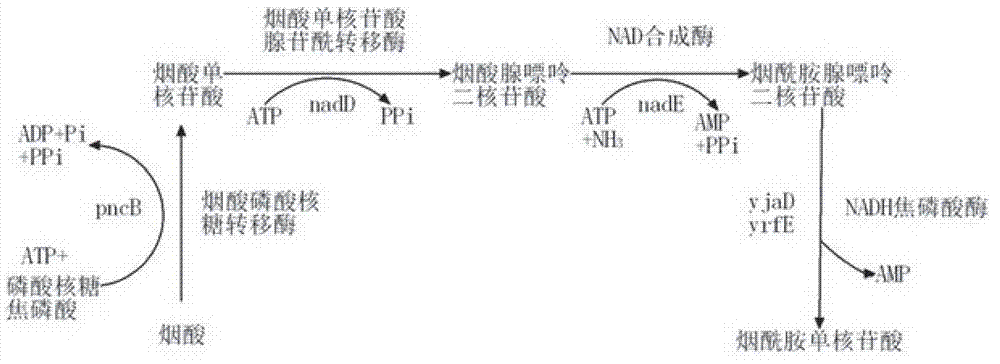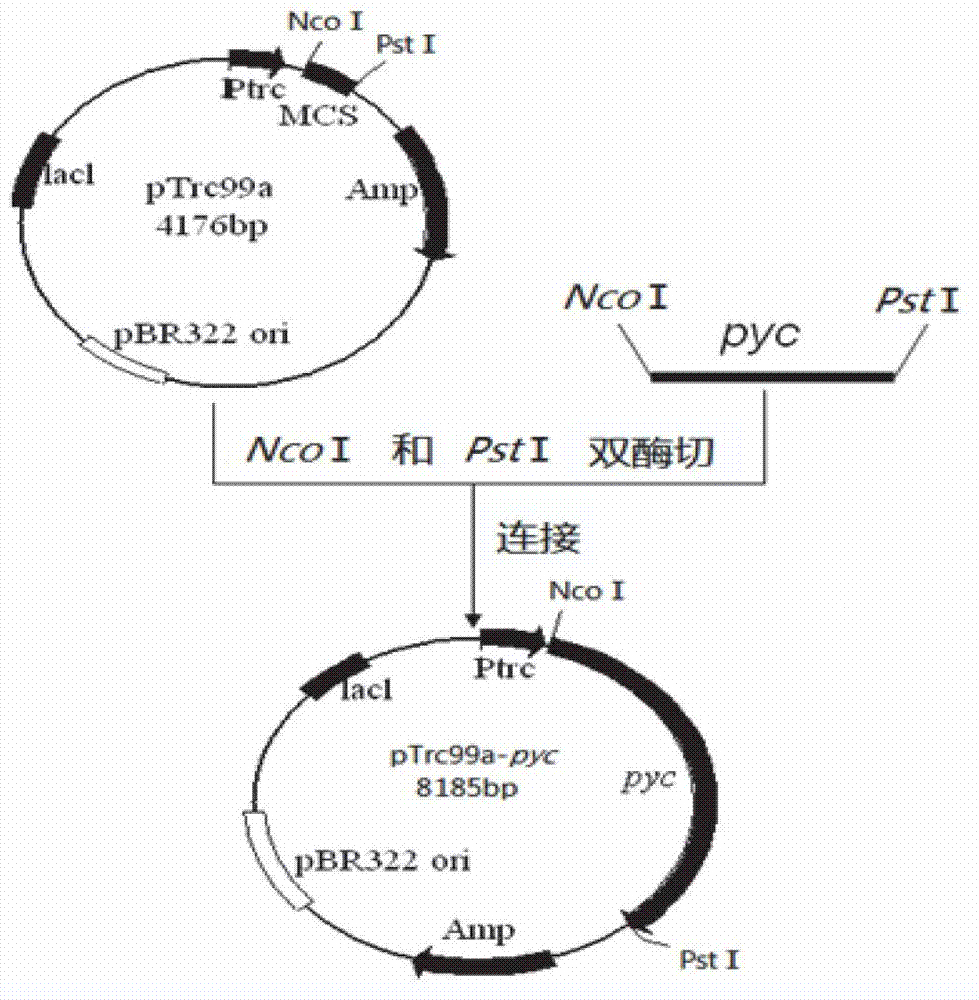Genetic engineering bacterium for producing succinic acid, and construction and application thereof
A genetically engineered bacteria and a technology for producing succinic acid, applied in the field of bioengineering, can solve problems such as growth inhibition, inability to utilize glucose, etc., and achieve the effects of strong acid-producing ability, simple and feasible fermentation method, and reduced production cost.
- Summary
- Abstract
- Description
- Claims
- Application Information
AI Technical Summary
Problems solved by technology
Method used
Image
Examples
Embodiment 1
[0040] Example 1 Construction of plasmid pTrc99a- expressing exogenous pyruvate carboxylase pyc The process includes:
[0041] 1. Synthesis with Nco I and Pst Primers for I restriction sites:
[0042] Upstream primer: 5'- CATGCCATGGTCAGCTGATGAGAAACGTCGAGAAG -3';
[0043] Downstream primer: 5'- AAAACTGCAGGGTCATTCTCTTCAAAGCCAAAACGA-3'.
[0044] 2. to Lactococcus lactis cremoris NZ9000 genomic DNA was used as a template, and the target gene fragment was amplified by PCR. The reaction conditions were: 94°C, 5 min; (94°C for 45 s, 53°C for 45 s, 72°C for 300 s, 35 cycles); 72°C, 10 min. purified amplified pyc After the gene, the expression plasmid pTrc99a was used Nco I double digestion, connection to obtain recombinant plasmid pTrc99a- pyc .
Embodiment 2
[0045] Example 2 Construct an expression plasmid that overexpresses pyruvate carboxylase and nicotinic acid phosphoribosyltransferase, restore the ability of the recombinant strain to metabolize glucose under anaerobic conditions, and obtain the strain Escherichia coli BA016.
[0046] 1. Construction of an expression plasmid for excessive co-expression of pyruvate carboxylase and nicotinic acid phosphoribosyltransferase, the process including:
[0047] (1) Both upstream and downstream primers are synthesized with Nco Primers for I restriction sites,
[0048] Upstream primer: 5'-CATGCCATGGGAAAGGTGGCATATGGTGTGATCGG-3';
[0049] Downstream primer: 5'-CATGCCATGGCGGCTACAGGCACAACGCTCATAAT -3'.
[0050] (2) Using the Escherichia coli K12 series as a template, amplify the target gene fragment by PCR. The reaction conditions are: 94°C, 5 min; (94°C for 45 s, 63°C for 45 s, 72°C for 96s, 35 cycles); 72°C , 10 min. purified amplified pncB After the gene, the plasmid pTrc99a-...
Embodiment 3
[0052] Example 3 Overexpression of newly constructed recombinant E. coli strains Escherichia coli The total amount of NAD(H) and NADH / NAD in BA016 and starting strain NZN111 + The comparison of the ratio, and the comparison of the sugar consumption and acid production capacity during the fermentation process of the two.
[0053] Escherichia coli NZN111 when introduced into plasmid pTrc99a- pyc - pncB Finally, the overexpression of pyruvate carboxylase and nicotinic acid phosphoribosyltransferase restored the redox balance of the recombinant bacteria under anaerobic conditions, and the total amount of NAD(H) was significantly increased, and it also restored the redox balance of the recombinant bacteria under anaerobic conditions. The ability to metabolize glucose, while the main product is succinic acid, without the accumulation of formic acid and lactic acid.
[0054] Using anaerobic serum bottle fermentation, Escherichia coli BA016 was inoculated into the fermentation...
PUM
 Login to View More
Login to View More Abstract
Description
Claims
Application Information
 Login to View More
Login to View More - R&D
- Intellectual Property
- Life Sciences
- Materials
- Tech Scout
- Unparalleled Data Quality
- Higher Quality Content
- 60% Fewer Hallucinations
Browse by: Latest US Patents, China's latest patents, Technical Efficacy Thesaurus, Application Domain, Technology Topic, Popular Technical Reports.
© 2025 PatSnap. All rights reserved.Legal|Privacy policy|Modern Slavery Act Transparency Statement|Sitemap|About US| Contact US: help@patsnap.com



